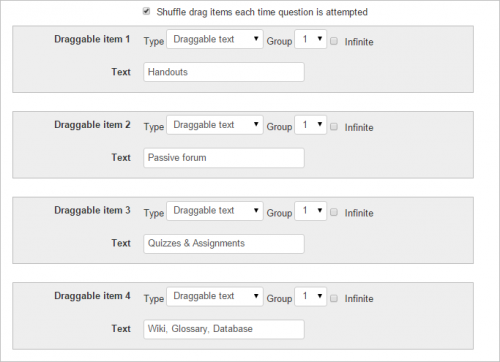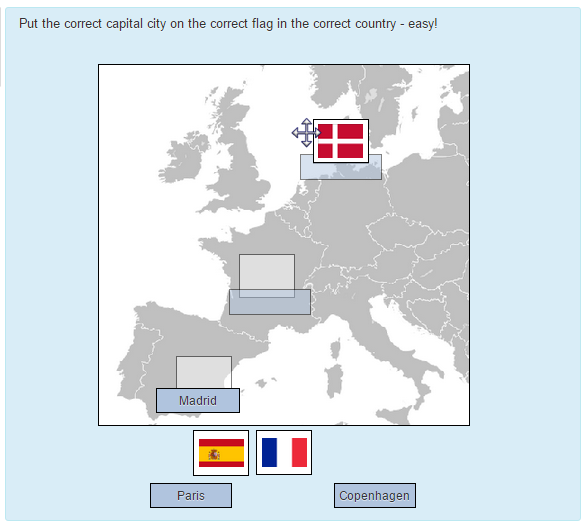Tipo de pregunta arrastrar y soltar sobre imagen
- Gestionando preguntas
- Comportamientos de preguntas
- Permisos de pregunta
- Tipos de preguntas
- Arrastrar y soltar al texto
- Arrastrar y soltar marcadores
- Arrastrar y soltar sobre imagen
- Calculada
- Calculada simple
- Calculada de opción múltiple
- Descripción
- Ensayo
- Relacionar columnas
- Respuestas incrustadas (Cloze)
- Opción Múltiple
- Ordenamiento
- Numérica
- Respuesta corta
- Relacionar columnas de respuesta corta aleatoria
- Seleccionar palabras faltantes
- Verdadero/Falso
- Preguntas de terceros
- Preguntas FAQ
Vea también:
¡Nueva característica
en Moodle 3.0!
Un tipo de pregunta en donde los estudiantes arrastran palabras, imágenes o ambas desde una lista y las sueltan dentro de huecos pre-definidos sobre de una imagen base. Este es un tipo de pregunta creado y mantenido por la Universidad Abierta del Reino Unido ( Open University ) que será parte del núcleo de Moodle a partir de Moodle 3.0) y como plugin adicional está disponible para Moodle 2.1 a 2.9 en el Moodle plugins database. Al momento de escribir esta documentación, este plugin ya había sido traducido al Español de México, pero no al Español internacional.
Esta página necesita actualizarse con la información existente en la documentación vigente/moderna/actualizada en el idioma inglés original para Moodle. Se le sugiere al lector que consulte la página original en idioma inglés cuyo enlace está al fondo de esta página. y que, por favor, actualice esta información y quite la plantilla {{Actualizar}} cuando haya terminado. (otras páginas pendientes de actualizar)
Como crear una pregunta
- Dele a la pregunta un nombre descriptivo, que le ayude a encontrarla dentro del [[Banco de preguntas**. (los estudiantes no verán el nombre
- Add the question to the text editor, using any formatting you wish.
- In the Preview section, click the background image button to upload an image. Larger images will be displayed at a maxiumum 600 x 400.Your image will then display under the file upload box.
- In the Draggable items section, you can upload images if you leave the type as 'draggable image' or you can type in words if you change the type to 'draggable text'. You may have a mixture of images and text.
- In the Drop zones section, you choose which items to go in which zone.
- You can then position the items on the background image and this will add their coordinates.
- Note:(1) Draggable images cannot be more than 150 x 100 pixels. If they are larger, they will be scaled on import. Remember to add a short text descriptor too.
- Note (2) You can format draggable text using <sub>, <sup>, <b>, <i>, <em>, <strong> and <br/>
- Note (3) Choices that are within the same Group are colour coded and may only be dropped on a drop zone with the corresponding colour. Choices that are marked as 'infinite' may be used in multiple locations.
Ejemplo uno
Basados en la documentación de Moodle acerca de Pedagogía, los participantes deben 'Subir la escalera de Moodle' al ordenar las etapas en el uso de Moodle como profesor.
En la sección de Vista previa, se sube una imagen básica de una escalera con escalones
En la sección de Ítems arrastrables, el 'typo' se selecciona como 'texto arrastrable' y se añade el texto de cada etapa. (En este ejemplo no se usan Grupos ni configuraciones infinitas)
En la sección de Zonas de descarga, se elige dentro del menú desplegable un ítem de entre las opciones previamente añadidas:
Entonces aparecerán estos textos debajo de la imagen del fondo:
Las cajas de texto son arrastradas hasta sus posiciones correctas sbre d ela imagen (los escalones de la escalera). Esto añadirá entonces automáticamente las coordenadas a a la sección de Zonas de descarga:
Se completan las otras configuraciones (vea debajo) y se guarda la pregunta.
Los participantes deberán de arrastrar las etapas de Moodle al los escalón correcto:
Ejemplo dos
Participants must add the correct country flag and capital city onto a map of Europe.
This question has images as well as text and makes use of the Groups feature.
In the Preview section, a basic map of Europe is uploaded.
In the *In the Draggable items section, the capital cities are added as the type 'draggable text' and the flags are added as the type "draggable image"
All draggable images (the flags) are in Group 1 and all draggable text items (the capital cities) are in Group 2.
In the Drop zones section, an item from the previously added options is chosen from the drop down. The Group 1 boxes will display in a different colour from the Group 2 boxes.
When the boxes are dragged to their appropriate places on the background image, the coordinates in the Drop zones section are updated automatically.
Other settings are completed (see below) and the question is saved.
Accesibilidad
Drag and drop questions are keyboard accessible. Use the <tab> key to move between the drop zones and the <space> key to cycle around the possible choices for each drop zone.
Puntuación
All gaps are weighted identically. Only drop zones that are filled correctly gain marks. There is no negative marking of drop zones that are filled incorrectly.
Whether or not Combined feedback is shown to students is governed by the Specific feedback setting on the iCMA definition form.
Penalty for each incorrect try: The available mark is reduced by the penalty for second and subsequent tries. In the example above a correct answer at the second try will score 0.6666667 of the available marks and a correct answer at the third try will score 0.3333334 of the available marks.
If the question is used in 'interactive with multiple tries' behaviour the marking is modified as follows:
- The mark is reduced for each try by the penalty factor.
- Allowance is made for when a correct choice is first chosen providing it remains chosen in subsequent tries.
Hint: You can complete as many of these boxes as you wish. If you wish to give the student three tries at a question you will need to provide two hints. At runtime when the hints are exhausted the question will finish and the student will be given the general feedback and the question score will be calculated.
Clear incorrect responses: When ‘Try again’ is clicked incorrect choices are cleared.
Show the number of correct responses: Include in the feedback a statement of how many choices are correct.
Vea también
- The original documentation page at the Open University site.
- 28/Tipo de pregunta arrastrar y soltar sobre imagen con la versión anterior de esta página






